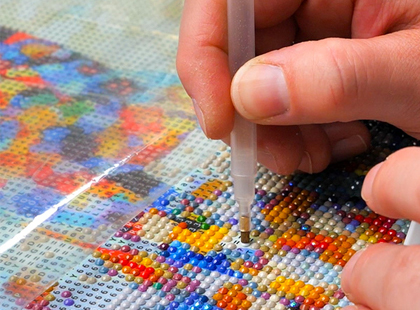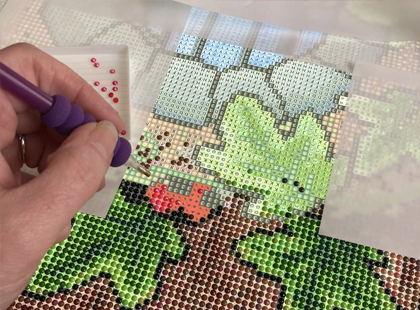Diamond painting has emerged as a popular and therapeutic art form in recent years, captivating people of all ages with its sparkling and intricate designs. At the heart of this creative activity lies a crucial component - release paper. Alongside its counterpart, release film, release paper plays a vital role in the diamond painting process, ensuring a smooth and enjoyable crafting experience. In this article, we will delve deep into the world of release paper for diamond painting, exploring its definition, structure, working principles, differences from release film, and its significance in the overall diamond painting process.
Before we explore release paper, it's essential to have a basic understanding of diamond painting. Diamond painting is a form of art that combines elements of painting and cross - stitching. A canvas is printed with a pattern, usually divided into small sections, each marked with a corresponding number or symbol that indicates the color of the “diamonds” (resin rhinestones) to be placed there. Crafters use a special applicator tool to pick up the tiny diamonds and place them onto the canvas, following the pattern. Once completed, the diamond painting shimmers and sparkles, creating a stunning visual effect.
Release paper, also known as release liner or backing paper, is a key material in diamond painting. It is a type of paper that has been treated with a special coating to prevent adhesion. In diamond painting, the release paper is attached to the back of the adhesive layer on the canvas. The adhesive layer is what holds the diamonds in place once they are applied.
Structure of Release Paper
Typically, release paper consists of a base paper layer and a release coating. The base paper can be made from various materials, such as wood pulp, synthetic fibers, or a combination of both. The choice of base paper material affects the strength, durability, and flexibility of the release paper. The release coating, usually a silicone - based or fluoropolymer - based material, is applied to one or both sides of the base paper. This coating creates a low - surface - energy layer, which reduces the surface tension and makes it difficult for other substances, like the adhesive on the diamond painting canvas, to stick to it.
Working Principle of Release Paper in Diamond Painting
When you start a diamond painting project, the release paper covers the adhesive layer on the canvas. As you work on the painting, you gradually peel back the release paper section by section. The adhesive underneath is protected by the release paper until you are ready to apply the diamonds. Once the release paper is peeled away, the sticky adhesive is exposed, and you can place the diamonds onto it. The non - stick property of the release paper ensures that the adhesive remains intact and effective, and the diamonds adhere properly to the canvas.


Release film is similar in function to release paper but is made from a different material. Release film is usually a thin, flexible plastic film, such as polyethylene (PE), polyester (PET), or polypropylene (PP). Like release paper, it is coated with a release agent to prevent adhesion.
Structure and Properties of Release Film
The structure of release film consists of the plastic film substrate and the release coating. The plastic film provides strength, transparency, and flexibility. PET release films, for example, are known for their high tensile strength, excellent dimensional stability, and good chemical resistance. The release coating on the film, just like on release paper, creates a non - stick surface. Release films can be clear or opaque, and some may have additional properties, such as anti - static treatment, to prevent dust and debris from adhering to the adhesive surface.
Application in Diamond Painting
In diamond painting, release film may be used in place of release paper in some cases. It serves the same purpose of protecting the adhesive layer on the canvas. Some diamond painting kits may use release film because it can be more durable and resistant to tearing compared to paper, especially for larger or more complex canvases. It also provides a smooth surface for peeling, which can be beneficial for crafters who prefer a more consistent peeling experience.
Material
The most obvious difference between release paper and release film is the material they are made of. Release paper is primarily composed of paper - based materials, while release film is made of plastic. This difference in material affects their physical properties, such as strength, flexibility, and durability. Release film is generally more tear - resistant and can withstand more handling without damage, whereas release paper may be more prone to tearing, especially if it gets wet or handled roughly.
Transparency
Release films are often transparent or semi - transparent, which can be an advantage in diamond painting. Crafters can see the pattern on the canvas through the film, making it easier to align the diamonds accurately. In contrast, release paper is usually opaque, so you need to peel it back to see the pattern clearly. However, some release papers may have a slightly translucent quality, but they are not as transparent as release films.
Cost
The cost of release paper and release film can vary. Generally, release paper is more cost - effective, especially for mass - produced diamond painting kits. The raw materials for paper production are more widely available and less expensive compared to the plastic materials used for release films. This makes release paper a popular choice for manufacturers who want to keep the cost of the diamond painting kits low. However, for high - end or specialized diamond painting products, the use of release film may be justified due to its superior performance and durability.
Protecting the Adhesive
The primary role of both release paper and release film is to protect the adhesive layer on the diamond painting canvas. The adhesive needs to remain sticky and free from dust, dirt, and other contaminants until the diamonds are applied. Release paper and release film act as a barrier, ensuring that the adhesive's stickiness is preserved and that the diamonds will adhere firmly to the canvas.
Facilitating the Crafting Process
They also play a crucial role in making the diamond painting process more manageable. By allowing crafters to peel back the release material section by section, it becomes easier to focus on one area of the canvas at a time. This step - by - step approach reduces the chances of accidentally sticking diamonds in the wrong place or smudging the adhesive. Additionally, the smooth surface of release paper and release film makes the peeling process easy and seamless, enhancing the overall crafting experience.
Peeling Technique
When peeling back the release paper or release film, it's important to do it slowly and carefully. Start from one corner and peel at a moderate angle, making sure not to pull too hard, which could damage the adhesive or the canvas. If you encounter any resistance, stop and check if there are any areas where the release material may be stuck.
Storage
Proper storage of diamond painting canvases with release paper or release film is essential. Keep them in a cool, dry place away from direct sunlight and moisture. Moisture can affect the adhesive and the integrity of the release material, while sunlight can cause the adhesive to degrade over time.
In conclusion, release paper and release film are indispensable components in diamond painting. Their unique properties and functions contribute significantly to the success of a diamond painting project. Understanding these materials can help crafters make the most of their diamond painting experience, ensuring beautiful and long - lasting results. Whether you are a beginner or an experienced diamond painting enthusiast, a good knowledge of release paper and release film will enhance your crafting skills and enjoyment.